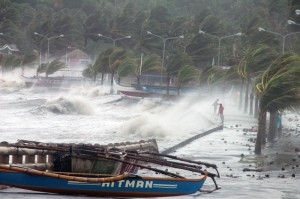Damage from super typhoon expected to be ‘catastrophic’
One of the most intense typhoons on record whipped the Philippines on Friday, killing three people and terrifying millions as monster winds tore roofs off buildings and giant waves washed away flimsy homes.
Super Typhoon Yolanda smashed into coastal communities in Samar before dawn on Friday with maximum sustained winds of about 315 kilometers an hour.
“We’ve had reports of uprooted trees, very strong winds . . . and houses made of light materials being damaged,” Philippine Red Cross chief Gwendolyn Pang told Agence France Presse on Friday afternoon as Yolanda swept across the Philippines’ central and southern islands.
The government said three people had been confirmed killed and another man was missing after he fell off a gangplank in Cebu City.
But the death toll was expected to rise, with authorities unable to immediately contact the worst affected areas.
“The winds were so strong that they flattened all the banana plants around the house,” university student Jessa Aljibe, 19, told AFP by telephone from the Samar city of Borongan shortly after Yolanda made landfall.
All telephone contact to the island was later lost as the typhoon moved inland.
“We have put rescue teams and equipment at different places, but at the moment we can’t really do much because of the heavy rain and strong winds. There is no power,” said Pang.
An average of 20 major storms or typhoons, many of them deadly, batter the Philippines each year.
It suffered the world’s strongest storm of 2012, when Typhoon Pablo left about 2,000 people dead or missing in Mindanao.
But Yolanda’s wind strength made it one of the four most powerful typhoons ever recorded in the world, and the most intense to have made landfall, according to Jeff Masters, the director of meteorology at US-based Weather Underground.
It generated gusts of 379 kph on Friday morning, according to the US Navy’s Joint Typhoon Warning Center.
Masters said the previous record for the strongest typhoon to make landfall was Hurricane Camille, which hit Mississippi in the United States with sustained winds of 190 miles an hour in 1969.
The US expert said he expected the damage in Guiuan, a fishing town in Samar of about 40,000 people that was the first to be hit on Friday, to be “catastrophic”.
Communication lines with Guiuan remained cut off in the afternoon, and the civil defense office said it was unable to give an assessment of the damage there.
In Tacloban, a nearby city of more than 200,000 people, corrugated iron sheets were ripped off roofs and floated with the wind before crashing into buildings, according to video footage taken by a resident.
Flash floods also turned Tacloban’s streets into rivers, while a photo from an ABS-CBN television reporter showed six bamboo houses washed away along a beach more than 200 kilometers to the south.
More than 125,000 people in the most vulnerable areas had been moved to evacuation centers before the typhoon hit, according to the National Disaster Risk Reduction and Management Council, and millions of others huddled in their homes.
Authorities said schools in the storm’s path were closed, ferry services suspended and flights cancelled.
In Metro Manila, which was on the northern edge of the typhoon’s path, many schools were closed amid forecasts of heavy rain.
One particularly vulnerable area in Yolanda’s path was Bohol, the epicenter of a 7.1-magnitude earthquake last month that killed 222 people.
At least 5,000 survivors were still living in tents on Bohol, and they were moved to schools that had been turned into evacuation centers.
Thousands of travellers were stranded as vessels stayed in ports to avoid Yolanda’s wrath.
The Philippine Coast Guard reported 2,995 stranded passengers in Sorsogon, Catbalogan, Samar, and Bacolod City.
Presidential Communications Secretary Herminio Coloma Jr. assured on Friday that the government has enough resources to help families affected by Yolanda.
Coloma said the government had prepositioned emergency relief resources amounting to P195 million that included 84,965 family food packs.
The funds for relief operations came from the budget of Department of Social Welfare and Development (DSWD).
Cellular service was cut off in Samar and Leyte.
Globe Telecom said that as of noon Friday, about 20 percent of its network in the Visayas was down. The typhoon also disrupted in about 6 percent of its network in the Mindanao area, said Robert Tan, Globe chief technical adviser.
Tan attributed the disruption to downed power lines. Antennas in some cell sites also became misaligned because of Yolanda’s monster winds.
Service areas affected by the typhoon in the Visayas include Biliran, Cebu, Eastern Samar, Leyte, Northern Samar, Southern Leyte, Western Samar and Iloilo.
Areas affected in Mindanao are the provinces of Camiguin, Dinagat Islands and Surigao del Norte.
The Department of Science and Technology’s Project NOAH (Nationwide Operational Assessment of Hazards) said areas in the typhoon’s path could experience tidal and storm-induced waves that could reach as high as 17 feet.
Project NOAH said Ormoc in Leyte could experience waves as high as 5.2 meters.
Major airports in the Visayas shut down on Friday.
At the Ninoy Aquino International Airport, 458 flights to and from Visayas and Mindanao were cancelled.
Billboard concessionaires at the airport were told to fold tarpaulins.
The airport management advised food outlets in the four NAIA terminals to stay open for stranded passengers.
The Civil Aviation Authority of the Philippines advised commercial airlines to transfer their planes from NAIA to Clark or Subic as a precaution.
In Quezon City, Mayor Herbert Bautista ordered the all the city’s emergency response teams to prepare for deployment to areas ravaged by Yolanda.
In Quezon province, which is on the fringe of the typhoon, a fisherman was reported missing.
AFP, CATHERINE S. VALENTE, FRANCIS EARL A. CUETO, BELLY M. OTORDOZ, VOLT PALAÑA, BENJIE L. VERGARA, ANTHONY VARGAS, AND JING VILLAMENTE


